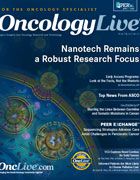"Trojan Horse" Tested in EGFR-Amplified Glioblastoma
Investigators are seeking to determine whether the addition of ABT-414 to concomitant radiotherapy and temozolomide will improve the survival of patients with newly diagnosed glioblastoma multiforme with EGFR amplification.
Martin J. Van Den Bent, MD
Investigators are seeking to determine whether the addition of ABT-414, an antibody—drug conjugate, to concomitant radiotherapy and temozolomide will improve the survival of patients with newly diagnosed glioblastoma multiforme (GBM) with epidermal growth factor receptor (EGFR) amplification.
The phase IIb/III Intellance1 trial (NCT02573324), which is currently recruiting participants, seeks to randomize approximately 720 patients to a 2-phase experimental arm with ABT-414 or to a placebo comparator arm. Participants in the experimental arm will receive intravenous ABT-414 combined with standard therapy of oral temozolomide and radiation in a chemoradiation treatment phase, followed by ABT-414 plus oral temozolomide during an adjuvant treatment phase. The comparator arm will follow the same regimens, with an intravenous placebo to replace ABT-414. (Figure).
Eligible patient will have newly diagnosed EGFR-amplified GBM, with a Karnofsky performance status of 70 to 100. The primary endpoints are progression-free survival (PFS) and overall survival (OS).
“A first question is whether the effects of ABT-414 are increased in the presence of temozolomide; there are some laboratory data that suggest this. Whether it should be combined with radiotherapy will be answered in the trial on newly diagnosed glioblastoma,” said Martin J. van den Bent, MD, PhD, of the Erasmus MC Cancer Center in Rotterdam, the Netherlands.
ABT-414 consists of a microtubule cytotoxin, monomethyl auristatin F, linked to a monoclonal antibody that recognizes the activated EGFR receptor, a key oncogenic driver in GBM. The agent, which also is known as depatuxizumab mafodotin or depatux-m, selectively targets cells with high levels of activated EGFR, such as cells with EGFR amplification or an EGFR variant III (vIII) mutation.
Its mechanism of action differs from tyrosine kinase inhibitors that inhibit EGFR signaling such as erlotinib (Tarceva) and gefitinib (Iressa) in that it binds EGFR and becomes internalized for direct cell killing. EGFR amplification has been defined as an EGFR/CEP7 ratio ≥2 in ≥15% of cells in tumor tissue.
“It is important to realize that although a patient with GBM often has EGFR abnormalities, amplification, or mutations, these are all in the extracellular domain. From other tumor types, we know that erlotinib and gefitinib work with a completely different type of mutation. ABT-414 is a different approach as we are using a sort of Trojan horse concept to use the receptor to get the cytotoxin inside a tumor cell,” van den Bent said.
At the 2017 ASCO Annual Meeting, held June 2 to 6 in Chicago, a pooled analysis of data from 126 patients with EGFR-amplified recurrent GBM treated during the efficacy analysis trial for ABT-414 were presented. The analysis included patients with EGFR-amplified recurrent GBM who received temozolomide plus ABT-414 and individuals with recurrent disease who were administered ABT-414 monotherapy. Overall, 47% of the participants had EGFRvIII mutation—positive disease.
Among these patients, the overall response rate was 10.4% including a 1.7% complete response rate and an 8.7% PR rate. The PFS rate at 6 months was 27.1% and the median OS was 8.5 months. A similarly encouraging disease control rate was observed (52%), with a 26% PFS rate at 6 months.
The most common adverse events (AEs) associated with ABT-414 were ocular toxicities (87%). According to van den Bent, this includes the occurrence of clinically significant—but usually reversible—keratitis in about 20% to 30% of patients, leading to eye pain, dryness, and loss of visual acuity. Patients also experienced blurred vision (60%) and photophobia (31%), which was also usually reversible. For some patients, these AEs led to dose delays or reductions, but symptoms tended to decrease and even disappear over time. Only 3% of patients experienced ocular AEs that caused treatment discontinuation. Common nonocular AEs included fatigue (36%) and headache (30%).
If the Intellance1 trial is positive, ABT-414 has the potential to become part of the standard of care in patients who suffer from GBM with EGFR amplification. This could also be an important proof of principle in the field of neuro-oncology. “These are exciting days, and we hope that ABT-414 will improve outcomes and lead the way to other treatment strategies,” van den Bent commented.
Another randomized trial investigating ABT-414, Intellance2 (NCT02343406), has recently completed its accrual. According to van den Bent, who is the primary investigator for Intellance2, patients will be randomized between 2 experimental arms, receiving ABT-414 monotherapy or ABT-414 with temozolomide, with OS as the primary endpoint.
Two control arms will treat patients with either lomustine or temozolomide, depending on the timing of the patient’s relapse. Patients who relapsed during or within 3 months from the end of first-line treatment with temozolomide will be treated with lomustine, and if they relapse later, those patients will be retreated with temozolomide. There is also a substudy for Intellance2, evaluating ABT-414 as a treatment for pediatric patients with high-grade gliomas.
ABT-414 is being developed by AbbVie, which is sponsoring the Intellance1 trial in collaboration with NRG Oncology’s Radiation Therapy Oncology Group.
Lassman AB, van den Bent MJ, Gan HK, et al. Efficacy analysis of ABT-414 with or without temozolomide (TMZ) in patients (pts) with EGFR-amplified, recurrent glioblastoma (rGBM) from a multicenter, international phase I clinical trial [ASCO abstract 2003]. J Clin Oncol. 2017;35(suppl). meetinglibrary.asco.org/record/146492/abstract.




